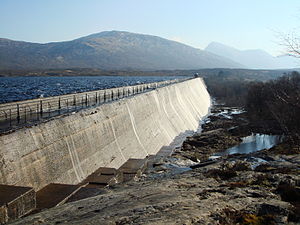Blackwater Reservoir

The Blackwater Reservoir is an artificial lake, a reservoir created behind a dam in the mountains above Kinlochleven, on the border of Inverness-shire to the north with Argyllshire to the south. At over 2,999 feet long, its dam is the longest in the Highlands.
This was once all part of the valley of the River Leven, which feeds the reservoir, but then in the early twentieth century the dam reservoir were created for a hydroelectric for the British Aluminium Company (later: British Alcan) for the purpose of smelting aluminium and was designed by engineers Patrick Meik and Charles Meik.
The dam, at 89 feet high, was built at an elevation of over 1,001 feet in rugged and almost inaccessible terrain, and involved the construction of some 3.7 miles of concrete aqueduct and nearly 8.1 miles of steel pipe in total, in four parallel pipelines.
The dam was built using hand tools, without the benefit of mechanical earth moving machinery, and has been described as the last major creation of the traditional 'navvy' whose activities in the construction of canals and railways left an indelible mark on the British countryside.
The power house and aluminium smelting plant were in Kinlochleven, which is adjacent to the sea loch Loch Leven.
In recent years the smelting works has closed and has mostly been demolished albeit that a few buildings remain and have been given over to other uses, including a climbing wall which - unusually - has a refrigerated face so that people can practice ice climbing.
The power station now produces electricity for the aluminium smelter in Fort William, supplementing the supply from the Lochaber hydroelectric scheme. Any surplus energy is sold to the national grid for public supply. Consequently the dam, penstocks and other works associated with it remain in use.
A number of workers lost their lives constructing the dam; their graves, which are marked by concrete markers, are close to the dam.